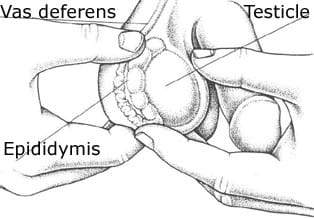How Do You Do a Testicular Self-Examination?
The testicular self-exam (TSE) is a way for males to check their own testicles to make sure there are no unusual growths, lumps or bumps. Unusual growths, lumps or bumps may be the first sign of testicular cancer.
Although testicular cancer is rare, it is most common between the ages of 15 and 35. If it is found early, treatment is usually very successful. Testicular cancer usually affects only one testicle (very rarely does it involve both testicles). Males should do a self-exam every month so they are more likely to notice changes in the size, shape or firmness of the testicles.
Signs and Symptoms of Testicular Cancer
- A lump or nodule on a testicle
- Enlargement or a change in the firmness of a testicle (the affected side might be noticeably larger than the normal testicle)
- A dull ache in the scrotum (the sac holding the testicles)
Examination of Testicles
- Examine testicles monthly during or after a warm shower or bath. This is when the scrotum is most relaxed and easiest to examine. Having soap on your fingers will help make the exam more comfortable.
- Normal testicles feel smooth and spongy and will move easily inside the scrotum. Feel the testicles for pea-sized lumps or other irregular areas at the front and sides of the testicles. There is a tubular, ropelike structure along the back of the testicle that is normal. This is called the epididymis.
- If you feel a hard lump on the testicle, call your doctor right away for an appointment to check the testicle.
- Lumps or bumps are not always cancerous but you should have your doctor check them as soon as possible. Testicular cancer is almost always curable if it is caught and treated early.
How to Perform the Exam

Follow these simple steps for a thorough TSE:
- Examine one testicle at a time, repeating the process described here.
- Use both hands to examine each testicle.
- Hold the testicle with one hand between your fingers and thumb. Use the other hand to feel the testicle and examine for any lumps or bumps.
- Roll the testicle between the thumbs and fingers with a gentle pressure that causes no pain or discomfort.
- Examine both testicles regularly, at least once per month.



